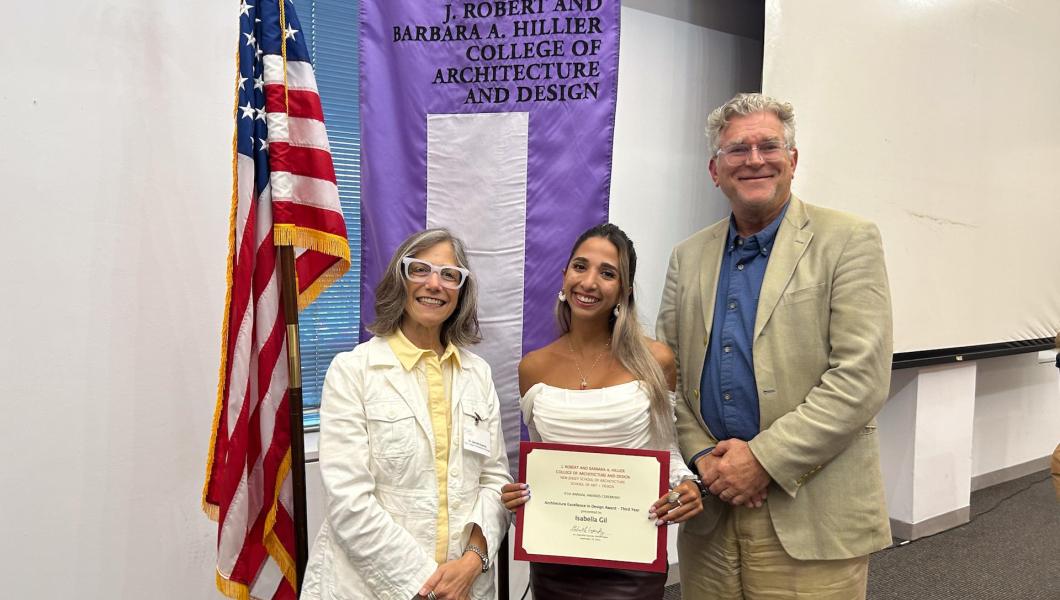The Hillier College of Architecture and Design History Project

This story was submitted by Maya Gervits.
As we approach the 50th anniversary of the New Jersey School of Architecture at the J. Robert and Barbara A. Hillier College of Architecture and Design, working on preserving the narratives of the college’s history seems both timely and necessary. Such a study can promote a better understanding of how the institution has evolved and help explore its relation within the university, local community, and other institutions concerned with architects’ and designers' education.
To date not much has been written about the history of the School of Architecture at NJIT. Using various sources, we were able to reconstruct a timeline going back to March 24, 1880, when the Essex County Assemblyman in the state Legislature introduced "An Act to Provide for the Establishment of Schools of Industrial Education." The Newark Technical School opened on February 9, 1885. Along with mathematics, chemistry, physics, mechanical engineering, free-hand drawing, mechanical drawing, English composition and rhetoric, the following year’s course listing included a course in architectural drawing.
The subject retained its popularity for many years, even into 1930 when the Newark Technical School was transformed into the Newark College of Engineering (NCE), with architecture being treated as a part of engineering.
After the war, there was a growing demand for courses satisfying the desire of "men and women to return to 'civilian' employment from the so-called 'war industries." The NCE established a series of twelve certificate programs including Civil Engineering Aids, Mechanical Design, Industrial Supervision, Electrical Engineering Technology, Tool Design, and Architectural Aids. At the end of 1950, "to offset the loss of architectural talent forced to leave the state for education," the New Jersey Society of Architects aimed to establish a school of architecture.
New Jersey School of Architecture Studio Space

However, it was not until 1973 that the State Board of Higher Education granted its authorization. With the addition of the New Jersey School of Architecture, the College of Engineering changed its name to the New Jersey Institute of Technology (NJIT).
“It was a very interesting period,” said Tony Schuman. “Harlyn Thompson became the first formal dean of the new school, and wanted to populate the schools with distinct areas of interest and expertise. There were the ‘architecture of social engagement’ practitioners: Troy West, C. Richard Hatch, founder of the Architects’ Renewal Committee in Harlem, Karl Linn, Leslie Wiseman an early feminist writer and thinker, then there were the conceptual designers, people like Michael Webb, Alan Wexler, Don Wall, and finally the building science faculty like Steve Zedepski and David Elwell.”
New Jersey School of Architecture Studio Review

“Back then things were more freewheeling,” Schuman continued. “Students used to set up their studios so they literally did not have to leave. The university had a motor pool and we would organize 3 day field trips to places with great architecture like Baltimore, Washington and Philadelphia. I remember when I decided to join the college is was because in the studio review I attended, one student presented on a convention center in New York city with excellent architectural drawings, the other designed a poetry center in Rutherford, and presented her designs in watercolors. There was and always has been a wide range of approaches to the practice of architecture.”
In 1998, the college received a new home in the renovated Weston Hall building. In 2008 with the inception of the School of Art and Design (A+D), which consisted of interior, industrial, and digital design programs, the NJSOA became a part of the newly formed College of Architecture and Design, which was subsequently renamed the J. Robert and Barbara A. Hillier College of Architecture and Design in 2019.
Schuman’s institutional memory and knowledge of people and events are what the Hillier College history project is looking to capture. In the rapidly changing information environment, academic libraries' nature and role are undergoing a fundamental shift, creating new opportunities for visibility. One such area is the use of technology to preserve general, institutional, and individual histories within academia. By archiving and analyzing individual, community, and institutional histories, it is possible to amplify narratives that constitute collective memory for future generations. In his article "Why a College Should Teach Its Own History," published in the Chronicle of Higher Education in 2016, Corey Ryan Earle discusses his experience at Cornell University, concluding: "Having observed more than 2,000 students in my classroom, I am a firm believer that one of the best investments a college can make is in teaching its own history."
Michael Mostoller with student

Over the years, the Littman Library has collected materials related to the college’s history, focusing on articles in newspapers, journals, and books, photographs and old slides, student portfolios and records of faculty scholarly activities, posters for various events, and other documents related to the college’s history, its programs and everyday life and activities.
Several years ago, we decided to add oral histories, which have been lately gaining more popularity as archival documents and could serve as a valuable bridge between the impersonal documentation of the past and the personal narratives of faculty and alumni. These interviews help to uncover information that is not accessible using such techniques as questionnaires and observation, forming a more complete picture of the history of the college. We plan to include materials on both schools, all programs, affiliated centers, and on the Littman Library from the early years through the present day. This is a work in progress and it cannot be completed without your contributions.
The Littman Library will publish a historical photo from the Social Image Database to the Facebook page each week hoping that people will help to identify themselves and/or their peers. If you would like to share your stories in audio recorded interviews, have photographs or memorabilia and are willing to submit these materials for digitization and inclusion in the collection, please contact us by email at maya.gervits@njit.edu and monica.kenzie@njit.edu.

